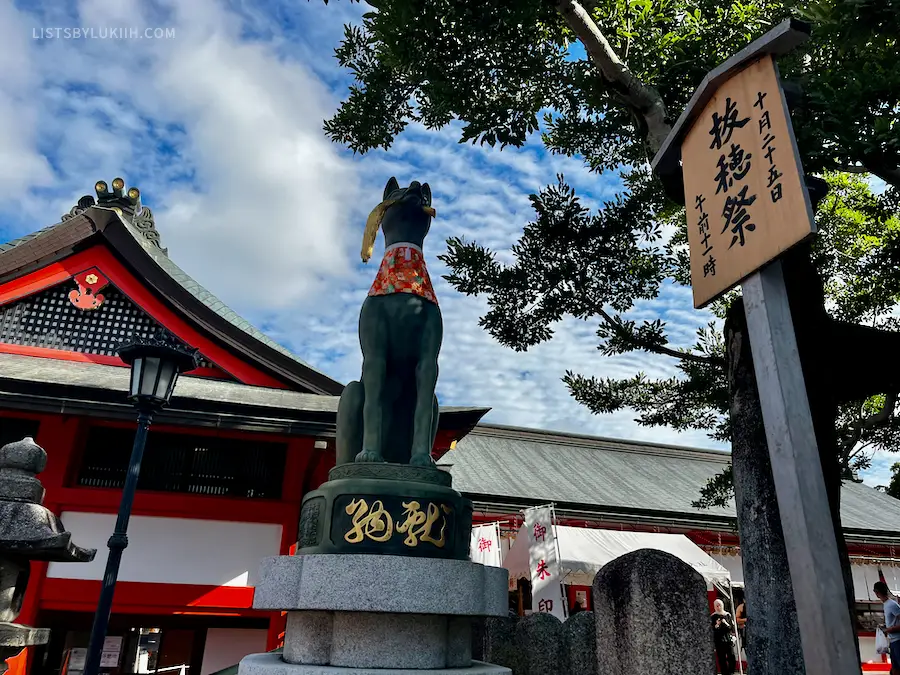Lists By Lukiih is readers-supported. When you buy with my affiliate link, I may earn a small commission. Thanks!
Overview of Japanese Culture
Japan is a country that highly values rule-following, orderliness, and thoughtfulness for those around them. The social norms are deeply ingrained into Japanese culture and heavily influence how people behave and treat others.
If you want to respect Japan’s cultural differences, here are thirteen things to avoid doing as a tourist in Japan.
This list has been informed and reviewed by several Japanese locals for accuracy.
🇯🇵 Planning a Trip to Japan: 12 Practical Things To Know
1. Talking Loudly in Public Places
One of the first things you’ll notice when visiting Japan is that it’s a remarkably quiet country. The lack of noise is immediately clear, including in major cities like Tokyo and Kyoto, where you expect it to be loud.
🤫 Why?
Japanese culture places special emphasis on respecting those around you. Talking loudly in public spaces is considered impolite as you’re disrupting the peace and tranquility of others.
Zen Buddhism, which emphasizes tranquility and mindfulness, has deep roots in Japan’s history and influences daily life today.
🍀 Lukiih’s Experience
I never saw any Japanese locals having phone calls or watching videos with the volume on crowded trains or streets. The loudest people on trains were most often tourists, which felt embarrassing given how quiet everyone else was.
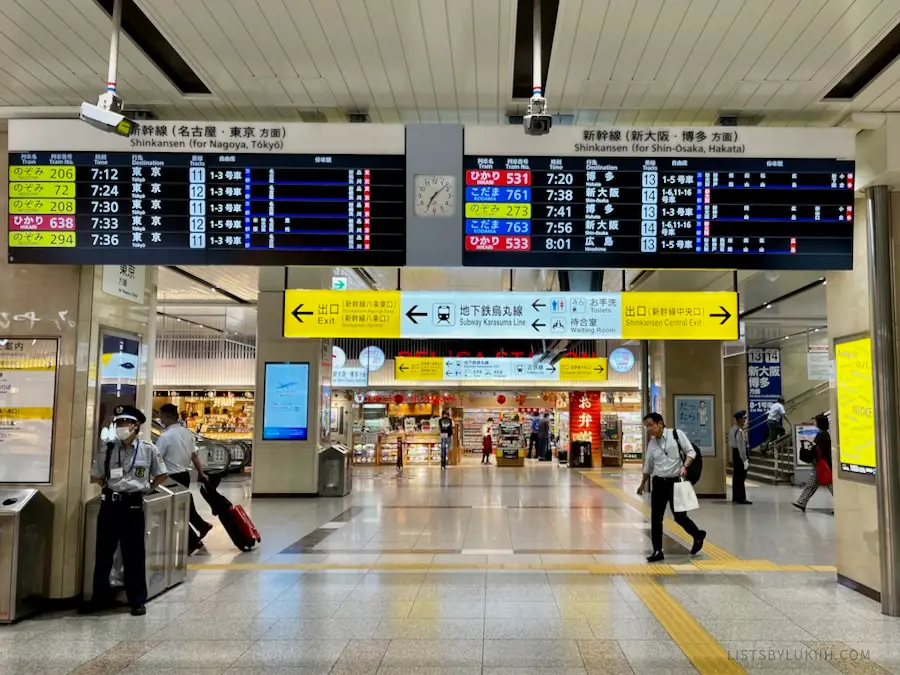
2. Eating While Walking
Japan has numerous street food vendors and convenience stores, so quickly grabbing food and going is tempting. But you’ll never see a local eating while walking.

🍣 Why?
It’s considered bad manners to eat and walk in Japan because doing so tends to lead to littering and nuisances to those around you. This goes against Japanese society’s emphasis on cleanliness and social harmony.
Eating is also considered a ritual and an experience in itself in Japanese culture, so doing it while walking is perceived as not fully appreciating the food.
In some markets, like Kyoto’s popular Nishiki Market, food stalls have signs that say things like, “Please eat the food in front of this store” to discourage walking and eating.
🍀 Lukiih’s Experience
As an American who views eating and walking as “efficient”, this was one of the easiest social norms to forget. The one time I accidentally did it, I saw subtle glances thrown my way and I was later told by a local friend that I was being impolite.
Also, Japan doesn’t have many street trash cans, so if you eat and walk, you’ll need to carry your trash with you. The streets are overall very clean, so make sure to do your part to preserve the cleanliness.
3. Wearing Shoes Indoor
In some indoor spaces, including Japanese homes, hotels, restaurants, and onsens, you’ll notice that outdoor shoes are left by the door and not worn inside. Taking off outdoor shoes is highly encouraged, but not required, at all Japanese accommodations.
Many places provide indoor slippers for you to wear instead. Some places even provide separate toilet slippers.
🩴 Why?
Removing outdoor shoes is a Japanese tradition with a long history dating as far back as 700 AD or earlier.
This practice helps keep the indoor space clean, which is particularly important in places where people sit on the floor or on tatami mats, which is a flooring material used in traditional Japanese rooms.
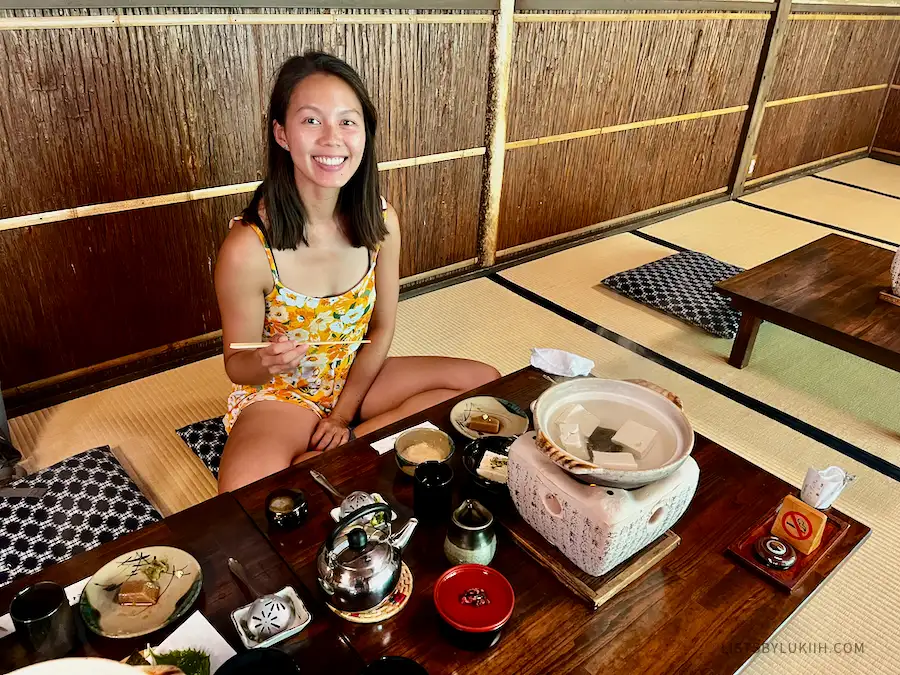
🍀 Lukiih’s Experience
All eight accommodations I stayed at in Japan, including my Mt. Fuji mountain hut, provided indoor slippers to encourage shoe removal.
I also ate at two Japanese restaurants that asked customers to remove their shoes. The establishments had tatami-style dining areas where people sat on the floor to eat.
If you’re not comfortable walking around with your bare feet, it’s a good idea to wear socks.
4. Bowing and Greeting
Upon arriving in Japan, you’ll constantly see locals bowing and greeting you. This includes bus drivers, hotel concierge, restaurant workers, and others.
🙇♂️ Why?
Bowing is an important way to show good Japanese manners and respect during a greeting. The culture around bowing can be complicated, as the depth and duration of the bow can signify different non-verbal things.
As a visitor in Japan, a quick bow is usually sufficient because locals understand that tourists come from different cultures.
🍀 Lukiih’s Experience
The rule I followed was that I always bowed back if someone bowed to me. A quick bow seemed better than no bowing.
Even construction workers did a quick bow to me while I passed them during my cycling trip on the Shimanami Kaido, a 37-mile path through Japanese islands.
5. Wearing a Towel or Swimsuit in an Onsen
Japan is known for its onsens (hot springs) and public baths. Most of them are sex-segregated, and nudity is required. Exceptions include private onsens, which are usually more expensive, and mixed-gender baths.
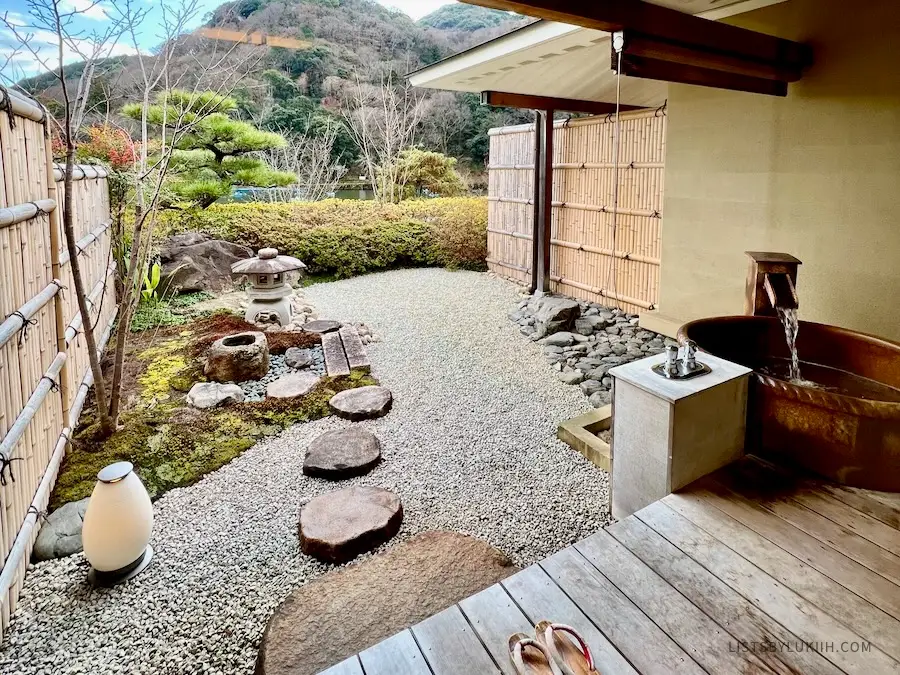
💧 Why?
Not only is bathing nude a Japanese custom that dates back centuries, but it also ensures that your skin makes direct contact with the mineral-rich water. Showering nude beforehand is also considered good manners for hygienic reasons.
Tattoos are looked down upon in Japan as they are associated with the Yakuza and other criminal groups. Some onsens may deny entry to heavily tattooed individuals. However, each onsen’s policy varies and a few are tattoo-friendly.
🍀 Lukiih’s Experience
As an American unaccustomed to public nudity, I did research on Japanese etiquette in onsens. I encourage you to do the same if you’re unfamiliar with them as it can help you feel less confused when arriving at one.
Having gone to two public onsens in Japan, I’ll also add that being nude feels less uncomfortable when everyone else is nude and behaving casually about the experience.
6. Tipping Service Workers
Japan does not have a tipping culture. Except for the standard 10% tax for most shopping items, you should expect to pay the stated price and not tip.
💴 Why?
Tipping is not a common practice in Japan because providing good service is the standard. Japanese people take pride in their work and don’t need a tip incentive to do their jobs well.
In some cases, tipping can create an awkward and confusing situation.
A good way to express gratitude in Japan is by saying thank you in its polite form: Arigatōgozaimasu. Many foreign visitors say “arigato”, which is the informal form and should only be used for close friends and family.
🍀 Lukiih’s Experience
As an American, tipping is very normal for me. In some instances, it even felt wrong to not tip. I got massages twice and found both services to be exceptional. Against my better judgment and due to habit, I tried to tip to show my gratitude.
One masseuse accepted it after I thanked them profusely while the other one refused it. Based on my experience, I recommend not tipping in most cases, but if you offer, don’t insist after they refuse because it can get awkward.
7. Standing on the Wrong Side of Escalators
Public transportation is the best way to get around Japan. As you travel around the country, you’ll see many escalators at train stations and Japanese people uniformly standing on one side of them, usually the left side.
🚇 Why?
Standing on the left side of the escalator is more efficient as it allows people who want to move quickly to take the right side. This is commonly understood in many places, but no country seems to execute it as well as Japan because the people there highly value being courteous to others.
Similarly, you’ll see that Japanese people tend to respect and form orderly lines. Train stations tend to have signs on the floor indicating the designated area for where to stand and form lines.
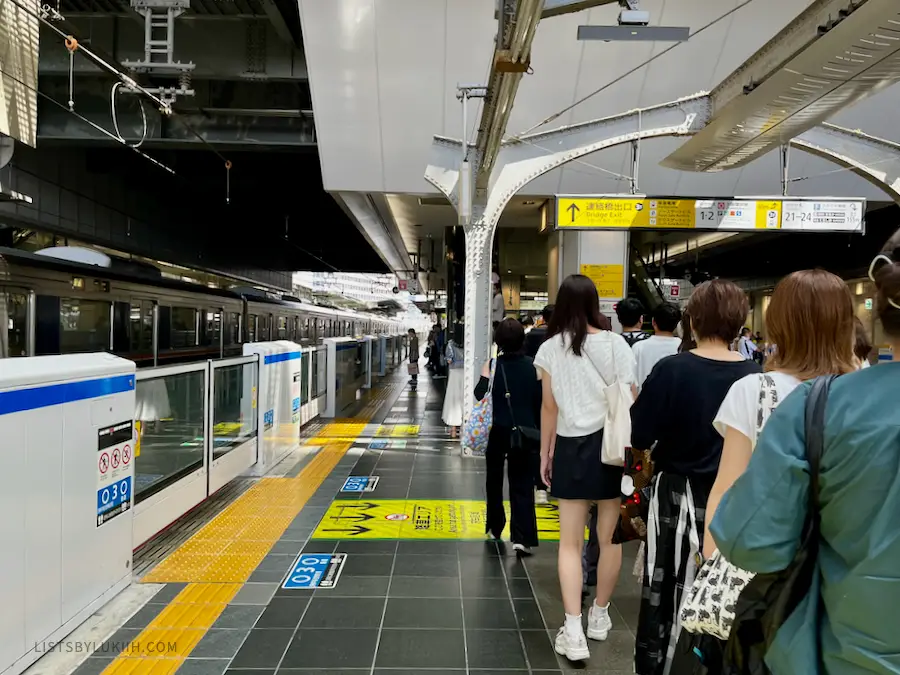
🍀 Lukiih’s Experience
I was amazed by how respectful people were of long lines and others even during times of rush hour. I even saw several couples stop holding hands and immediately line up single file up an escalator even if no one was around them.
If you’re unsure about which side you’re supposed to stand or walk, a general rule of thumb is to copy what all the locals are doing.
8. Pointing With Your Index Finger
You’ll notice that Japanese people will point or direct you to things with their whole hand instead of with their index fingers.
✋ Why?
Japan has strict social norms to not offend others. In Japanese culture, pointing with an index finger is associated with calling out someone for bad behavior and should therefore be avoided if that’s not what you’re trying to do.
Picking up objects, like credit cards, with just two fingers should also be avoided for a similar reason. It’s more polite to receive things with two hands facing up.
🍀 Lukiih’s Experience
This etiquette most frequently came up when I had to pay. I tried to remember to take back my credit card with two hands instead of just grabbing it.
Japan has a good credit card infrastructure, but many places are still cash-only.
💰 My Japan Trip Cost: Budget Breakdown (2025)
9. Jaywalking
Jaywalking in Japan is uncommon. Many people wait at the traffic lights for the walking signal to turn on even when there’s no oncoming traffic.
🚦 Why?
Japanese culture stresses rule-following, so most locals will wait for the red light before crossing.
If you need more motivation to respect the rules of the road, you should know that the police will often enforce the rules by issuing warnings or fines.
🍀 Lukiih’s Experience
I found that Japan’s infrastructure and cities are well-designed for efficient flow of traffic. It was easy to be patient and not jaywalk like I often do in places like New York City.
10. Ignoring the Garbage Sorting Bins
Public trash cans are not common on the streets of Japan, but you’ll find them in convenience stores, train stations, and parks. You’ll notice most of them have labels that separate trash into different bins, including paper, cans, and plastic.
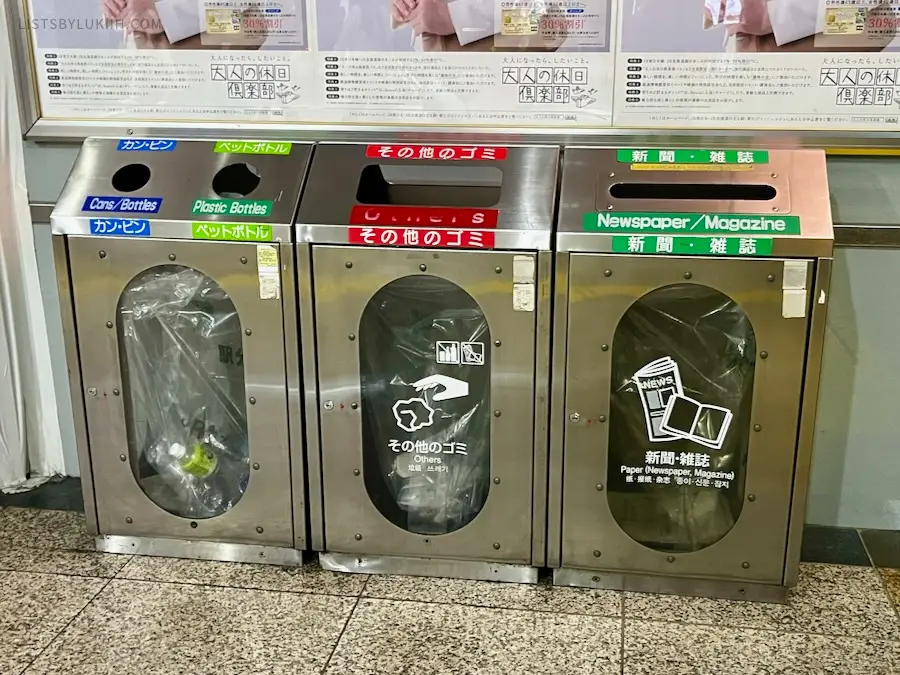
🗑️ Why?
Japan is not a big island and there’s limited space for landfills. Not sorting your trash correctly into the bins can be considered a disgrace since you’re perceived as not taking care of others in your community.
Most trash cans that have sorting bins will have a picture (e.g., of a plastic bottle, can, or newspaper) and English words to help you sort trash correctly.
Vending machines often have a trash can with a circle-shaped opening to indicate that only plastic bottles should be thrown in there.
🍀 Lukiih’s Experience
Different cities have varying recycling and trash sorting rules, so it can be a bit confusing to follow all of them.
I found that Kyoto had the most confusing rules, but knowing that someone might have to reclassify my trash later motivated me to try to abide by them as much as possible (I even got a thank-you note from the hotel for sorting my trash correctly, which felt nice).
11. Taking Photos Without Asking for Permission
Japan is a beautiful country where many visitors want to take photos of the scenery, attractions, and even the locals. However, make sure to not take photos of others without asking for permission first.
📸 Why?
It’s a social norm to ask others whether you can take photos of them in Japan. Not doing so is considered an invasion of privacy and is disrespectful.
Some Japanese attractions (which can even include food stalls) will have a “no photography” sign, which you should respect.
For example, the Gion district in Tokyo is known as the “Geisha District” for the many geisha walking around. Taking photos of them is not only considered disrespectful, but can result in a fine close to $100 USD.
🍀 Lukiih’s Experience
While I didn’t purposely take photos of people, I did notice that when I was taking a photo of a scenery, food stall, or attraction, many locals would move away to not be in the photo.
Likewise, one of my local friends said that many tourists take photos of kimono-wearing women without their consent in Kyoto, which is considered disrespectful.
12. Facing the Wrong Way When Using Squat Toilets
One of the most incredible ordinary things you’ll notice in Japan is how clean public restrooms are. Occasionally, you’ll also see squat toilets (usually in parks or more rural areas) and those tend to be clean as well. Make sure to face the toilet “hole” when using squat toilets.
Japanese toilets are also some of the most high-tech toilets you’ll ever see. Many of them will have two flushing modes (“flush” and “light flush”) to conserve water.
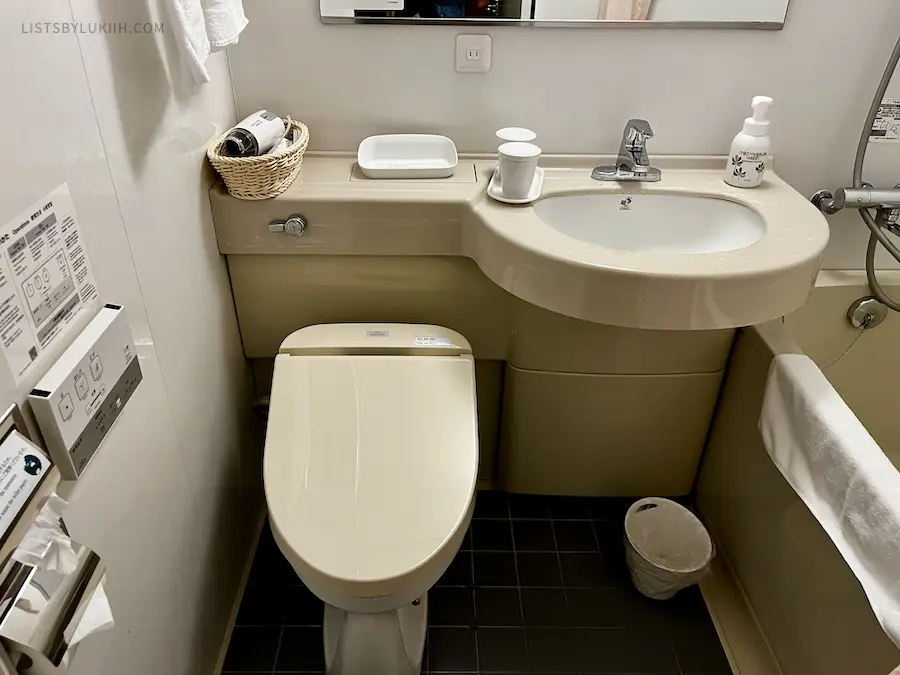
🚽 Why?
Facing the right way when using the squat toilet helps minimize splashing. Maintaining a clean bathroom is part of the Japanese culture’s emphasis on cleanliness.
🍀 Lukiih’s Experience
I was blown away by how clean public toilets are in Japan, especially compared to any public restroom in America. While most Japanese bathrooms had high-tech toilets, I did have to use a squat toilet twice during my two-week trip.
13. Sticking Your Chopsticks up on a Rice Bowl
Chopsticks are the preferred utensils in Japan and you’ll see that locals do not stick theirs up in a rice bowl. Instead, they place theirs facing horizontally on trays and tables.
🥢 Why?
Chopsticks sticking straight up from a rice bowl resemble the Japanese ritual of placing incense in rice at funerals. Because of the association with death, sticking chopsticks up is considered bad luck and disrespectful in Japan.
🍀 Lukiih’s Experience
I admittedly didn’t pay attention to how others placed their chopsticks while eating, but a local friend highlighted this as something that tourists should avoid doing while visiting Japan.
⛩️ 10 Epic Days in Japan: A Unique & Active Itinerary
Japan Trip Planner 2025
Make planning easier with my flexible, research-backed travel planner—shaped by real experience. It has:
- Up-to-date travel info
- A well-curated itinerary
- Practical, firsthand insights & tips
- A simple budget tracker
- A starter packing list
- Fully customizable sections
Built in Notion, this is the tool I personally use to plan every trip. I genuinely love it and creating a Notion account is free.
Lists by Lukiih is a small site I fund myself. Downloading my trip planner is the best way to support me and keep it running—thanks!

Japan Travel Guides
- 🇯🇵 Planning a Trip to Japan: 12 Practical Things To Know
- ⛩️ 10 Epic Days in Japan: A Unique & Active Itinerary
- 💰 My Japan Trip Cost: Budget Breakdown (2025)
- 🌋 Hiking Mt. Fuji: Honest Review & Tips
- 🚲 Cycling Shimanami Kaido: Honest Review & Tips
- ⛩️ Fushimi Inari Taisha: Honest Review & Tips
- 🙅🏻♀️ Etiquette in Japan: 13 Things Tourists Should Not Do
- ☀️ Visiting Japan in September: Tips & What To Know
- ❄️ Visiting Japan in December: Tips & What To Know
